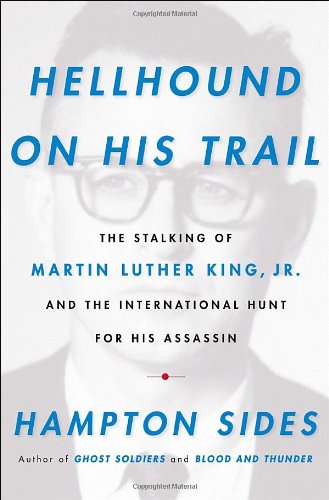
Hellhound on His Trail
The Stalking of Martin Luther King, Jr. and the International Hunt for His Assassin
کتاب های مرتبط
- اطلاعات
- نقد و بررسی
- دیدگاه کاربران
نقد و بررسی

Starred review from February 8, 2010
The counterpoint between two driven men—one by a quest for justice, the other by an atavistic hatred—propels this engrossing study of the King assassination. Sides, author of the bestselling Ghost Solders
, shows us a King all but consumed by the flagging civil rights movement in 1968 and burdened by presentiments of death. Pursuing him is escaped convict James Earl Ray, whose feckless life finds a belated, desperate purpose, perhaps stimulated by George Wallace’s presidential campaign, in killing the civil rights leader. A third main character is the FBI, which turns on a dime from its long-standing harassment of Kingto a massive investigation into his murder; in Sides’s telling, the Bureau’s transoceanic hunt for Ray is one of history’s great police procedurals. Sides’s novelistic treatment registers Ray as a man so nondescript his own sister could barely remember him (the author refers to him by his shifting aliases to emphasize the shallowness of his identity). The result is a tragedy more compelling than the grandest conspiracy theory: the most significant of lives cut short by the hollowest of men. Photos.

February 15, 2010
From veteran journalist and historian Sides (Blood and Thunder, 2006, etc.), a riveting account of James Earl Ray's long quest to kill Martin Luther King Jr.
Prisoner 416-J, late of the state penitentiary in Jefferson City, Mo., spent a large part of the first months of 1967 perfecting a circus-ready form of yoga. With it, as Sides's vigorous account begins, he folded himself into an impossibly tight space, namely a breadbox, and fled from prison, criss-crossing the country before winding up in Los Angeles and attending bartender school. Somewhere along the way, he fell under the spell of George Wallace, the firebrand Alabama governor who had promised segregation forever, and took it as his earthly task to kill King. According to Sides, Ray's timing was never quite right until he found a hotel room across from King's in Memphis, Tenn., and took his fateful shot. He escaped, again following a tortuous course that eventually took him to Portugal and other faraway points. Finally captured and imprisoned, he managed to escape again—one might assume with help, though the author discounts this possibility. Ray was soon recaptured, and he died in prison in 1998. Sides follows Ray in a nearly minute-by-minute account that has all the fascination, if little of the inevitability, of Frederick Forsyth's Day of the Jackal (1971). The author does not speculate unduly on conspiracy theories of the sort advanced by Ray's brother, John Larry Ray, in his 2008 book Truth at Last, but there is room for the careful reader to imagine that someone helped him along on his hunt for King—after all, as Sides observes,"he must have had an accomplice—or several accomplices" to have made good his escape from Jefferson City.
An expertly written study in true crime, vividly recapturing the mood of 1968.
(COPYRIGHT (2010) KIRKUS REVIEWS/NIELSEN BUSINESS MEDIA, INC. ALL RIGHTS RESERVED.)

Starred review from March 1, 2010
Martin Luther King's murder on April 4, 1968, which destroyed Lyndon Johnson's hopes for a Great Society and fragmented beyond repair the nonviolent Civil Rights Movement, was neither the result of an FBI conspiracy nor the impulsive act of a deranged killer, claims Sides ("Blood and Thunder: An Epic of the American West"), but rather a carefully planned assassination by James Earl Ray. Sides follows Ray from his escape from the high-security Missouri State Penitentiary, a year before the murder, to Mexico and then to Los Angeles, where Ray, a lifelong racist drifter going by the alias Eric S. Galt, fell under the political spell of presidential candidate George Wallace. Galt stalked King in Selma, AL, and in the civil rights leader's hometown of Atlanta before fatally shooting him in Memphis, TN. Sides's riveting account shows how the FBI, along with the Royal Canadian Mounted Police and Scotland Yard, worked through a mountain of leads and evidence to build an indisputable case against Ray. VERDICT Sides skillfully weaves his narrative as his book builds to the fateful conjunction of King and Ray in Memphis and to Ray's capture in London two months later. The results are a spellbinder that all interested readers will find hard to put down.Karl Helicher, Upper Merion Twp. Lib., King of Prussia, PA
Copyright 2010 Library Journal, LLC Used with permission.

Starred review from April 1, 2010
In 1967, an escaped prisoner, drifter, and racist, while voluntarily working on the presidential campaign for George Wallace in California, got the idea of stalking and killing Martin Luther King Jr. Using the alias Eric Galt, he traveled to his native South and kept track of King as the civil rights leader marched in Memphis for the striking garbage collectors. Galt, whose real name was James Earl Ray, methodically planned and executed the assassination then fled to Canada and Europe, hoping eventually to immigrate to South Africa. Drawing on interviews and previously unpublished resources, Sides builds suspense on parallel tracks of the civil rights leader and the assassin as the day of their shared destiny approaches. In the second half of the book, Sides offers riveting details of the FBI investigationleads, blind alleys, conspiracy theoriesamid rumors that the agency and its leader, J. Edgar Hoover, were somehow behind the assassination. Sides captures the zeitgeist of the 1960s: the racial tumult, the populist backlash, the counterculture self-realization mood. Despite the fact that readers know much of the history, they will be swept up in the narrative because Sides writes with immediacy, intimacy, and the pacing of a thriller.(Reprinted with permission of Booklist, copyright 2010, American Library Association.)

























دیدگاه کاربران